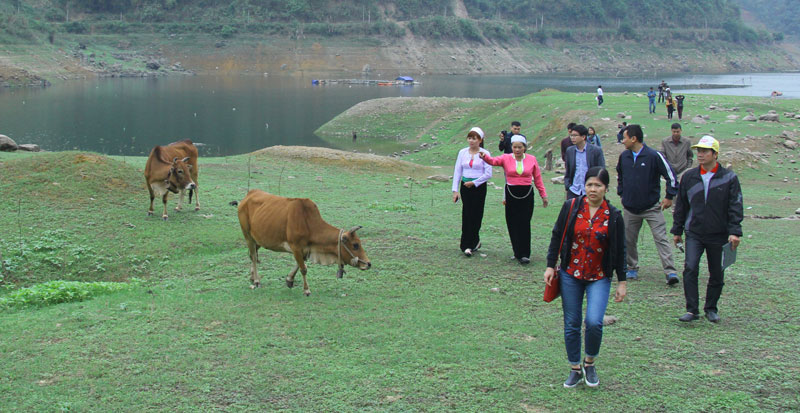
(HBO) – Ke hamlet in Hien Luong commune, Da Bac district, the northern mountainous province of HoaBinh, is an ideal destination in Hoa Binh lake area for visitors who wish to explore nature and culture.
Tourists
can reach Ke hamlet, which is located along Hoa Binh lake with 80 Muong
households, via waterways and roads. It takes about 15 minutes to walk from the
centre of Da Bac town to Hien Luong commune. Tourists can also depart from Bich
Ha Port in Hoa Binh city and travel around Hoa Binh lake for an hour before
reaching Ke hamlet.

Visitors
will cross a grass cover along the lake on the way to Ke hamlet, Hien Luong
commune (Da Bac district) by water.
Two
families in Ke hamlet, including HuuThao’s and Sanh Thuan’s, offer home-stay
services. Three more households will provide the service soon. The local
landscape, culture and people have attracted visitors near and far, as
reflected through the increasing number of holiday-makers. Apart from
international tourists and local students, Ke hamlet also welcomes families.
Visitors will have a chance to explore mountains, imposing forests and vast
lakes in Ke hamlet, and live with locals.
Home-stay
service suppliers and locals will guide tourists on how to discover Ke hamlet.
Holiday makers should base on their vacation length to
arrange the activities they want to do on their own ways when staying in the
locality. They can row, swim in lakes or streams, ride bikes and walk in the
jungle, or join locals in harvesting rice, fishing, hunting and weaving. They
can also go with locals into the jungle to dig bamboo shoots, which can be
boiled, roasted or used to make soup. Fishing and taking a view of the lake
during moonlit nights is the enjoyable experience. The lake is rich in shrimp
and fish, from African carp to carp, chub, pike, and even trionychid turtle.
Tourists can catch crabs and fish
while bathing in Ke Spring. Other local specialties are chicken, grilled and
steamed fish and buffalo meat with "lom” leaves.
Those who like adventure tourism can
climb Bieu Mount to explore culture of the Dao Da Bac minority group in Sung
hamlet, Cao Son commune. When the night falls, holiday-makers gather around the
campfire, enjoying Ruou Can (wine drunk out of a jar through pipes) and Ruou
Hoang (wine made of forest plant leaves) and dancing.
Rowing the boat to enjoy the beauty
of mountains and houses along the river will give tourists peaceful feelings.
But holiday-makers should wear life jackets to ensure safety.
After a day of exploring, visitors
will take a rest in clean and neat stilt houses looking over the lake and
surrounded by orchards. /.
Le
Chung
A diverse chain of eco-tourism and resort destinations concentrated in Hoa Binh city and the districts of Tan Lac, Da Bac, and Luong Son… Along with the launch of several key high-quality resort tourism projects, these developments have reshaped the landscape and enhanced the appeal of Hoa Binh as a travel destination.
Boasting diverse terrain, a mild climate, and rich natural resources, Cao Phong district is increasingly asserting its place on Vietnam’s tourism map, attracting both domestic and foreign visitors. The district is renowned for its stunning landscapes, majestic mountains, a crystal-clear hydropower lake, and the unique cultural identity of local ethnic groups.
With its pristine landscapes, unique cultural heritage of Muong ethnic minority, and an expanding range of visitor experiences, Tan Lac district of Hoa Binh has fast become a captivating destination for both domestic and international tourists.
Until now, Sung village in Cao Son commune, Da Bac district remains the only Dao ethnic community in Hoa Binh province to develop a community-based tourism model. Beyond its untouched natural landscapes, cultural identity serves as the cornerstone attraction for visitors.
Alongside the diverse cultural identities of the Kinh, Muong, Tay, Thai, Dao, and Mong ethnic people, Hoa Binh province is also renowned as the "capital" of the northwestern Vietnamese cuisine, offering unique and distinctive dishes. At festivals, during Lunar New Year (Tet), or on significant family or community occasions, special dishes are prepared, leaving a lasting impression on visitors.
A Phong Linh (Yellow Tabebuia) flower garden in Thang village, Thach Yen commune, Cao Phong district is currently in full bloom, drawing a large number of visitors.



